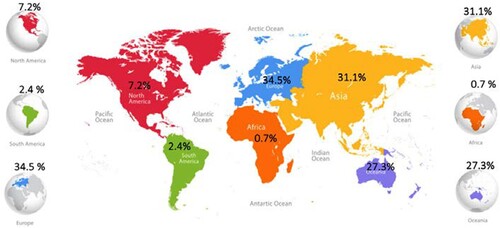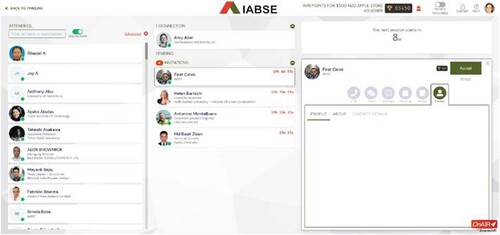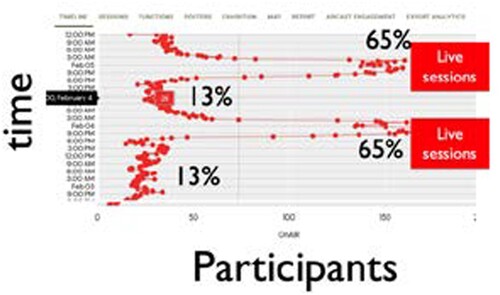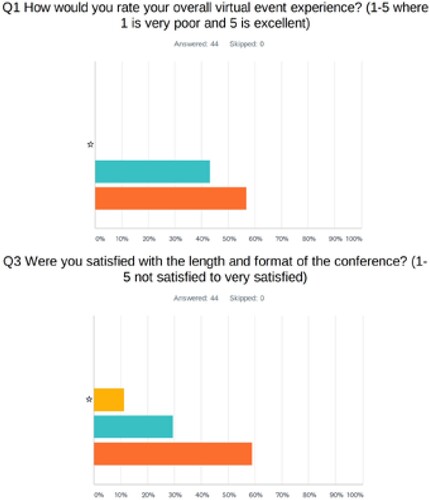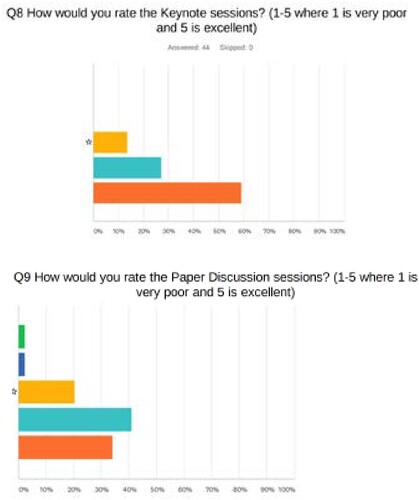by Alessandro Palermo, Prof., Chair of the Organising Committee; Anthony Abu, Assoc. Prof., Chair of the Scientific Committee, New Zealand
IABSE has never held a major international event in New Zealand, and Christchurch represented the first opportunity to remedy this. The regret is that we were (this time) deprived from IABSE visiting this fascinating country. In fact, IABSE Congress 2020, originally scheduled to be held on 2–4 September 2020, was postponed to 3–5 February 2021. In September 2020, given the continuous uncertainties related to the COVID-19 pandemic, the Scientific and Organising Committee Chairs decided to shift into a fully online delivery format and to focus on a strong technical programme.
The New Zealand Group of IABSE selected “Resilient Technologies for Sustainable Infrastructures” as the theme for our IABSE Congress 2020 since the expression encapsulates the resilient plan and sustainable development of Christchurch after the devastating 2010 and 2011 earthquakes. The congress theme has been underpinned by specific topics including earthquake engineering, durability, forensic engineering, performance-based fire engineering, performance under multi-hazards, rehabilitation and modification of structures, and sustainability.
The Congress had a total of 15 Keynote Speakers, 7 invited speakers and 38 parallel sessions, and the on-line participants were just under 300 from all over the world, as per the figure.
The 15 Keynote Speakers, including the Major of Christchurch, Lianne Dalziel, delivered inspirational talks under the following seven special themes.
Theme: NZ Seismic Resilience—experience from the Canterbury earthquakes
Building Resilient Communities, Lianne Dalziel, Mayor of Christchurch City Council, New Zealand
Seismic Safety and Energy Efficiency: Raising the International Bar to Enhance Community Resilience and Sustainability, Prof. Stefano Pampanin, Sapienza University of Rome, Italy
Theme: Structural fire for vertical and horizontal infrastructure
“Adequacy” in Performance-Based (Fire) Engineering, Prof. Luke Bisby, University of Edinburgh, UK
Strategies for Mitigating Fire Hazard in Bridges, Prof. Venkatesh Kodur, Michigan State University, USA
Theme: Sustainability and resilience in the design of bridges and buildings
Inventive Approaches to Seismic Resiliency, Mark P. Sarkisian, Skidmore, Owings & Merrill, USA
Technologies for Sustainability in a Seismic Country, Dr Akio Kasuga, Sumitomo Mitsu Construction, Japan
Keynote session snapshot: Mark Sarkisian presenting in the session theme “Sustainability and resilience in the design of bridges and buildings” with Dr. Akio Kasuga (top right corner) and Dr. Andreas Lampropoulos (bottom right corner) acting as a chair.
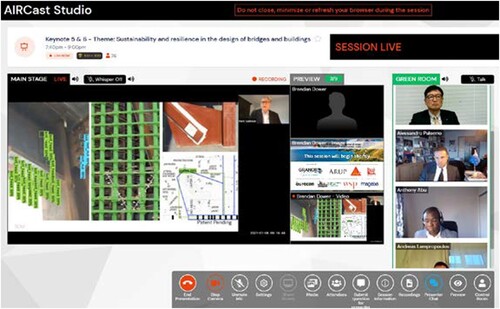
Theme: Finding forms and materials in structural design
Five pedestrian bridges—construction opportunities and constraints, Peter Burnton, ARUP, Australia
Move now, Knut Stockhusen, Schlaich Bergmann Partners, Germany
Keynote session snapshot: Peter Burnton (left) and Knut Stockhusen (right) presenting in the session theme “Finding Forms and Materials in Structural Design” and Barry Wright (bottom center) acting as a chair.
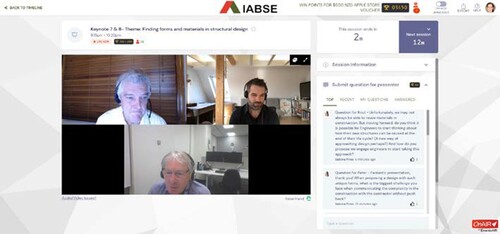
Theme: Digital engineering the new frontier of civil engineering
Disruptive innovation in sustainable concrete construction, Prof. Philippe Block, ETH Zurich, Institute of Technology in Architecture, Switzerland
Sensible cities, Prof. Carlo Ratti, Massachusetts Institute of Technology, USA
Theme: The history, the failure and the renaissance of the Morandi Bridge
Riccardo Morandi and his invention, Prof. Tullia Iori, Tor Vergata, University of Rome, Italy
Design, construction, life and failure of the Morandi Bridge, Prof. G. Michele Calvi, IUSS, Scuola Universitaria Superiore, Italy
Genova's San Giorgio Bridge, the history of the deck project from concept to testing, Angello Vittozzi, Technical Director, Italferr, Italy
Theme: The future challenge: extending the life of the existing infrastructure
Hybrid monitoring of bridge structures, Prof. Limin Sun, Tongji University, P.R. China
Risk, resilience, sustainability, and climate adaptation of infrastructure in a life-cycle context, Prof. Dan Frangopol, Lehigh University, USA
Four invited speakers showcased major New Zealand infrastructure projects, while the New Zealand Young Engineers Group led by Dr Gabriele Granello organised an IABSE Young Engineers special session that had three invited speakers.
New Zealand Special Sessions
Auckland Harbour Bridge emergency repairs, Will Pank, Beca, New Zealand
Perry Bridge network arch, Tim Brook, Holmes Consulting, New Zealand
Austroad guideline, asset management, Barry Wright, New Zealand Transportation Agency
Bridge asset management—the challenge of our generation, Jeremy Waldin, WSP, New Zealand
IABSE Young Engineer Special Session with Insights from Three Emerging Engineers
Stories from the road to innovation, Dr Sakthy Selvakuramaran, University of Cambridge, UK
My innovation journey from research to practice, Dr Kam Weng Yuen, Beca, New Zealand
The challenges of innovation, Dr Manya Deyanova, Mott MacDonald, UK
All the keynote and invited speaker talks were well received and the Q/A sessions were so lively that the moderators extended discussion timeslots to almost double the originally allocated time.
Interactive Q/A session snapshot: A7 Bridge Engineering 7 – Design projects: paper discussion session.
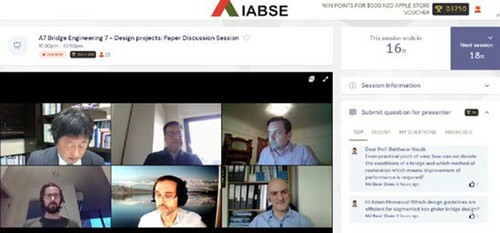
The 38 parallel sessions were run by using a “flipped class” delivery mode where all the presentations were recorded and made available on the online platform by 18 January 2021. The participants had to watch them and submit questions to the moderators beforehand. During the Congress, the sessions were question and answer discussions properly moderated by two chairs.
The features of the innovative virtual platform allowed a stable technical programme to be delivered, but also opened the opportunity to interact with industry supporters through product demos and visiting their virtual exhibition booths. The Congress was supported by the following seven sponsors.
Granor Rubber & Engineering, GOLD Sponsor
Sika Switzerland, SILVER Sponsor
ARUP Australia, SILVER Sponsor
Tongji Architectural Design, SILVER Sponsor
Aurecon New Zealand, BRONZE Sponsor
WSP New Zealand, BRONZE Sponsor
Eco-Rubber Geotechnical Seismic-Isolation Foundation System, University of Canterbury, BRONZE Sponsor
Mageba Switzerland, Keynote Session Sponsor
Despite the conference being fully online, the platform also opened various opportunities for networking outside of the conference sessions via small randomly selected conversation groups, larger discussion groups or via the Meeting Hub, which allowed one-to-one side conversations with attendees to be held, either via instant messaging or video calls. See the figure.
We wanted to encourage participant interaction with the virtual event as much as possible and the platform also allowed the inclusion of a gamification feature where each participant earned points for prizes by interacting with certain aspects of the platform. The winner and recipient of a 500 NZ dollar voucher was Biswaijt Pal, with more than 19,000 points.
The online attendance during the three days of the conference was close to 65%, generally with spikes during the morning keynote sessions due to time zone differences. However, more than 13% of the participants navigated through the platform outside the time scheduled for the technical programme. We had, overall, more than 1800 views during the live sessions. The keynote and invited talk presentations are now available on the platform and the Organising and Scientific Chairs jointly with the Professional Conference Organiser (PCO) are continuously monitoring post-conference views. The numbers are really encouraging.
Alessandro Palermo (on the left), Anthony Abu (on the right), University of Canterbury, Christchurch, New Zealand

The outcome of a post-conference online survey highlighted the following key aspects: (1) the online platform was well-received, easy to navigate and stable; (2) the attendees really appreciated the rich technical programme offered; (3) the duration of the conference was right, although time difference challenges still need to be addressed—see some survey result snapshots.
YEP Award
A dedicated panel chaired by Dr Gabriele Granello reviewed 52 papers and presentations, shortlisted 13 and the panel unanimously agreed to award the following two presenters
Lubomir Matejicka, Denmark (Ice-shedding and aerodynamic investigations of bridge cables with steel wire meshes)
Bartosz Siedziako, Norway (Experiences from the wind-tunnel testing of the Hardanger Bridge section model).
The success of IABSE Congress 2020 Christchurch was due to the many people who volunteered their time to support our technical programme. We are very grateful to the keynote and invited speakers for sharing their insights, to the 90-member Scientific Committee who oversaw the review of 462 paper abstracts and 260 paper submissions, as well as the 26 technical session moderators.
A big thank you also goes to the Congress Sponsors who supported this event in such an unprecedented, difficult and uncertain time.
Final special mention also goes to the IABSE HQ in Switzerland, the New Zealand Group of IABSE, students from the Department of Civil and Natural Resources Engineering, University of Canterbury, and the Professional Conference Organiser—Conferences and Events—who constantly supported our directions during this three-year journey.
Thank you to all who participated in this Congress, and, for those who could not attend the Congress, remember that this is the first “Congress for life” and you can still register and watch the entire technical programme at your own pace! www.iabse.org/Christchurch2020. The Conference Proceedings are available from IABSE’s Online Shop.

